Historical
Paintings and Computer Graphics Introduction Computer-graphics is an art technique using computers which automatically
compute both the modeling of the form and the shading of the light by
applying logical algorithm to generate a picture. On the other hand the creative artists try to realize their own ideas in their own work on a white canvas. The orientations which intend to the abstract logic and to realize the idea in the work seems as if they have the opposite direction. However by the fact that the one tries to observe the pattern behind
the seemingly chaotic reality and the other tries to realize that pattern
in their work, we can say that both make a circle in the same creative
horizon. Come to think of it, then, we can say that both the picture which the artists draw their own image on the canvas and the program that is written in IC chips exist in the virtual world beyond the influence of the gravity. Both try to cerate the virtual world of reality. This paper descusses both "modeling" and "shading" of the historical paintings while referring to the modern experimental CG algorithm. |
|
 |
1) The challenge of the artist Before the age of the personal computer, the artist tried difficult challenges to express their art by using the mainframe-computer. In 1973, "The First Annual International Computer Art Exhibition", held at the SONY Salon in Tokyo, the committee collected Computer Art work from the all over the world . At that stage their output devise had a very limited capacity like a line-printer which could print only letters, and XY-plotter to drew a line by pen, and vector-scanning-CRT, etc. |
 |
2) Working process of the representational painting
Working process to sketch "dessin(French)" can be divided into two phases : "modeling" and "shading", namely, the one is to understand the structure of the form and the other is to make the forms visible by using the shading of the light. CG algorithm is greatly advanced by the emergence of the frame-buffer-memory and the raster-scanning-CRT. "Half Tone Animation" by University
of Utah 1972, is the 16mm documentary movie that recorded a working process
of the CG. You can see here the process in which they generate the wire-frame image of the model by plotting and coordinating the XYZ-point on the surface of the plaster model. After that, they compute the light value of the each flat-polygons and finally make them the smooth surface. |
 |
However this approach to the shading technique generates
rather strange image because it does not have a concept as to the source
of the light. The light-value is calculated by the angle made by the viewers
standpoint only.
This unrealistic shading is resembled like the one used by Giotto's "Meeting at the Golden Gate" The Scrovegni Chapel, Life of Joachim, 1304-6, and Botticelli's "The Birth of Venus" 1482. |
 |
3) Modeling The drawing by simple straight line demonstrate a comprehension of the structure of shapes. The Renaissance perspective drawing, "cup"15c, exhibited an understanding for the structure of shapes through the use of straight lines, in the manner of "wire-frame modeling". |
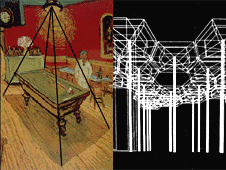 |
In "The Night Cafe"
by van Gogh 1888, the pool table looks twisted or deformed off first look.
However this image is drawn strictly by following the rule of the perspective
geometry, which shows clearly the serious character of the artist.
We can see by looking this twisted shape the fact that perspective geometry is not in accordance with space recognized by visual sense. |
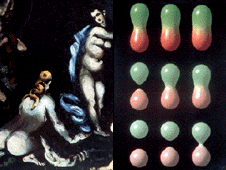 |
Other than the wire-frame method, there are other methods
to generate the shape by CG, namely the meta-ball technique and or the fractal
geometry approach.
In the wire-frame method, the shape is defined by using the binary digits
(0 or 1). But in meta-ball method the shape is defined by using the multi-values. Delacroix said that when we draw a picture, we must draw it as if some
kind of the ball is taking shape from within to the outside. |
 |
In fractal geometry CG, the complicated shape is generated
by applying the simple program repeatedly to make a whole within whole endlessly.
In fractal geometry method, we can recognize the new mathematical space generated by the computer, which is different from the three-dimensional space we can normally sense in our daily life. |
 |
4)shading Leonardo Da Vinch said in his note "Tratise of Painting"1436, that we could get the most light when the incident angle is close to the vertical and the darkest when the light angle becomes near horizontal. According to "Lambert principle" discovered by Lambert in the 19c, which widely used in the methodology of the CG Shading technique, the light-value reflected on the surface of the material is directly proportional of the cosine function to the angle made by the incident of light and vector line of the surface. The shading technique described by Leonardo and this Lambert principle explained one and the same thing. However Leonardo said it is not a good idea to draw shadow because the shadow distort the form of the things we draw and make the original color of the things impure. Leonardo said in another part of the note that the wide diffusion source of the light make the form and color most beautiful to the eye. |
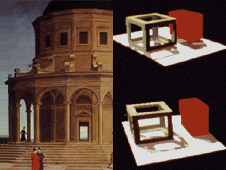 |
Raphael painted the simple shading in "The
Marriage of the Virgin" 1504, follows faithfully to the Leonardo's
theory. However, if it is a fine day drawn as in the background of the picture, the shadow part of the building must reflect the diffusing light of the blue sky and its color becomes not a simple dark color; therefore there is an inconsistency of the light in the building and the background landscape in this picture. In Lambert CG method, the dark side, which is not illuminated by light, does not have any data-value so it becomes totally black.Therefore we must add the obscure environmental light to make the shape of the dark side visible to the eye. Likewise, the background becomes total dark as in the cosmic space. |
 |
Leonardo draws the Platonic-cube for the illustration to "Holy Proportion" by Pacioli 1499. We can see in this picture the only beautiful shade but not a shadow. Also, in "Mona Lisa "1505, we can not see a clear shadow anywhere in the picture. This picture is illuminated by the light without shadow. In the perspective technique developed in Renaissance art, the form is determined by the viewers standpoint. Likewise in Leonardo's picture, the main-light in the picture is the virtual light emanated from the viewer. We can see the approximate method to Leonardo's elegant obscure shading
technique in "Radiosity" at Cornell University 1987. |
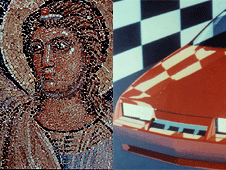 |
5) Expression of materiality by the real light source
and In the creating process of the mosaic art, artist must clearly determine the shape, color, and location of the each piece of the mosaic. Byzantine mosaic art in "Angel",
which was discovered on the wall of the Islamic Temple in Istanbul, we
can see the clear expression of the sunlight location, which is high-lighted
by several white spots on the Angel's facial surface. Also, we can see in this picture that the part which is not directly illuminated by the sunlight is colored purple. On the contrary the background space of the Angel is colored deepblue to get the mystical effect . And Angel looks golden reflect the sunlight. We cannot see such effective use of the real light in the art of the European Middle Ages. In "Rendering Technique" used in the field of the industrial design, we use the effect of the reflection to create the real sense of the material. |
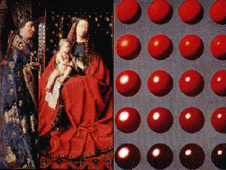 |
The realistic light of the Roman period experienced a revival
during the Northern Renaissance. van Eyck's paintings, "the Madnna with Canon Van der Paele" 1435 and "Portrait of the Arnolfini" 1434 , are based upon the principles of optical integration. In the Study demonstrated at the Cornell University, they simulated the sense of the materiality by following the variant-value of the function of the reflection and degree of the smoothness on the surface. |
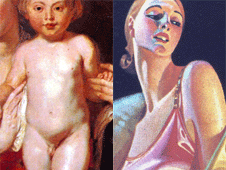 |
In "Grosse" by
Rubens1616, we can see the slightly red colored skin which is not illuminated
by the direct light. Red colored because the two closely located human bodies
reflect light emanating from each other and reddened by the filter effect
of the skin color.
And, in "Madonna in Blunenkranz"
by Rubens1620, we can observe the slightly blue shade which does not belong
to the part not illuminated by both direct light and indirect light on
the baby's body. Today we have a new light source with the
invention of the electric light. In this modernism illustration
of the lady who leaves a crowded party room to get some flesh air; the
artist tries to create the dramatic effect by using the contrastive color
of the cold and warm color.
|
 |
6) Object and its environment CG algorithm, which
computes exactly the effect of the real light, is called ray-tracing. Here we can see in "Checkered pattern and glass bead" by Bell Institute 1980, the output of the automatic calculation of the effect by the glass bead reflection, which is beyond the imagination of the artist. Checkered pattern created by the refraction inside the glass beads and reflection on the surface of the beads. In "Le Pont de L'Anglais" by
van Gogh 1888, we can see the shadow of the drawbridge is colored sky
blue which is caused by the reflection from the light of the water surface. We can now say that to draw an object is to draw the environment in which the object finds itself. Impressionists devote themselves to the effect of the light had already discovered the basic fundamentals of the ray-tracing technique. |
Lewis Mamford pointed out that before the
invention of the machine, the machine had already been created in the
minds of the people. As we have already seen, in historical picture like in Leonard's obscure diffused light, van Eyck's expression of the materiality, van Gogh's light of the sun and blue sky, artists tried to the algorithm, which has much commonality with today's CG method. C.G. algorithm gives a clear equation to the otherwise obscure theory
of the art and create the new theory based upon what was previously known.
|
|